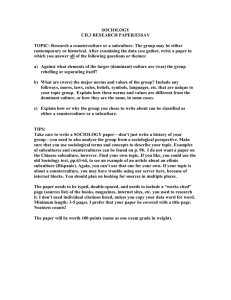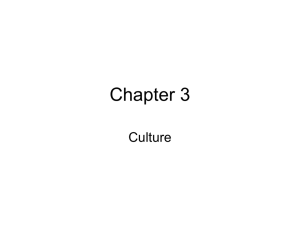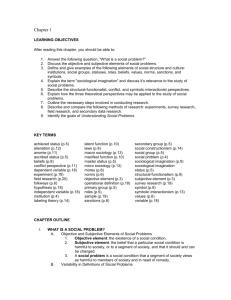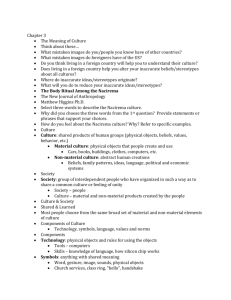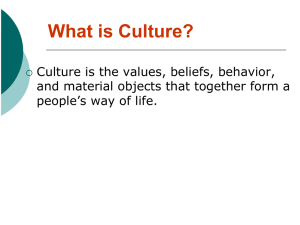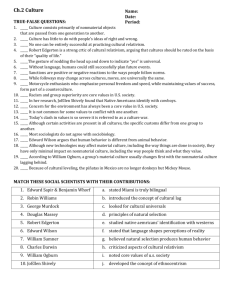1. Anthropologist Horace Miner's description of
advertisement
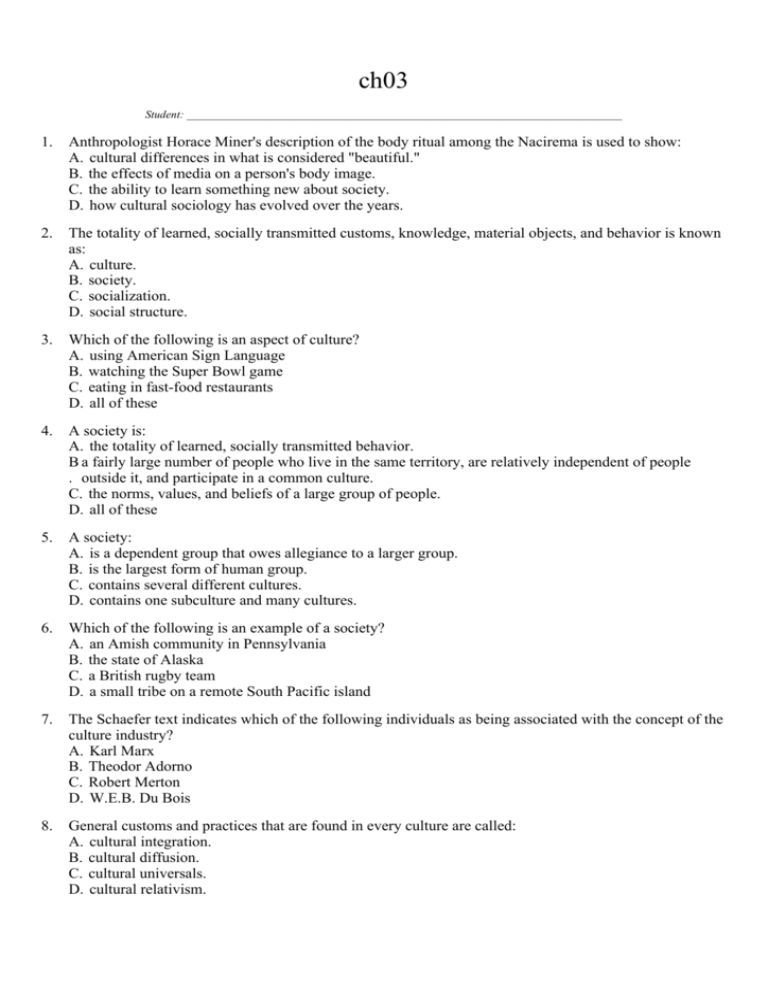
ch03 Student: ___________________________________________________________________________ 1. Anthropologist Horace Miner's description of the body ritual among the Nacirema is used to show: A. cultural differences in what is considered "beautiful." B. the effects of media on a person's body image. C. the ability to learn something new about society. D. how cultural sociology has evolved over the years. 2. The totality of learned, socially transmitted customs, knowledge, material objects, and behavior is known as: A. culture. B. society. C. socialization. D. social structure. 3. Which of the following is an aspect of culture? A. using American Sign Language B. watching the Super Bowl game C. eating in fast-food restaurants D. all of these 4. A society is: A. the totality of learned, socially transmitted behavior. B a fairly large number of people who live in the same territory, are relatively independent of people . outside it, and participate in a common culture. C. the norms, values, and beliefs of a large group of people. D. all of these 5. A society: A. is a dependent group that owes allegiance to a larger group. B. is the largest form of human group. C. contains several different cultures. D. contains one subculture and many cultures. 6. Which of the following is an example of a society? A. an Amish community in Pennsylvania B. the state of Alaska C. a British rugby team D. a small tribe on a remote South Pacific island 7. The Schaefer text indicates which of the following individuals as being associated with the concept of the culture industry? A. Karl Marx B. Theodor Adorno C. Robert Merton D. W.E.B. Du Bois 8. General customs and practices that are found in every culture are called: A. cultural integration. B. cultural diffusion. C. cultural universals. D. cultural relativism. 9. In his research, George Murdock determined which of the following to be a cultural universal? A. war B. astronomy C. funeral ceremonies D. all of these 10. Which of the following is considered a cultural universal? A. athletic sports B. war C. money restrictions D. none of these 11. A list of cultural universals was compiled by anthropologist: A. Max Weber. B. George Murdock. C. Margaret Mead. D. William F. Ogburn. 12. The tendency to assume that one's own culture and way of life represent the norm or are superior to all others is called: A. culture shock. B. cultural relativism. C. ethnocentrism. D. value stability. 13. The concept of ethnocentrism was originally formulated by: A. Seymour Martin Lipset. B. W.I. Thomas. C. William F. Ogburn. D. William Graham Sumner. 14. A member of a new fundamentalist church believes that she has found the one true way to achieve salvation and members of other religions are pagans and will go directly to hell when they die. This individual is: A. xenocentric. B. ethnocentric. C. culturally relative. D. monophobic. 15. Ethnocentrism is the tendency to assume that one's own culture and way of life represent the norm or are superior to all others. Therefore, ethnocentrism fosters cohesion in a group. This observation would best reflect which sociological perspective? A. functionalist perspective B. conflict perspective C. interactionist perspective D. feminist perspective 16. A U.S. sociologist receives a grant to study racial and religious prejudice among the people of Southeast Asia. The sociologist makes a serious and unbiased effort to evaluate the norms, values, and customs of these groups in light of the distinctive cultures of which they are a part. This is an example of: A. xenocentrism. B. ethnocentrism. C. cultural relativism. D. cultural deconstruction. 17. Which of the following concepts employs the kind of value neutrality in scientific study that Max Weber saw as being so important? A. xenocentrism B. cultural integration C. cultural relativism D. ethnocentrism 18. Sociobiology is the systematic study of the: A. social structure within the animal kingdom. B. interactions between humans and higher animal forms. C. social bases of biological behavior. D. how biology affects human social behavior. 19. Which of the following would be of interest to a sociobiologist? A. the social origins of human culture B. how social interactions shape human behavior C. how behaviors that are advantageous to survival become genetically linked to human beings D. all of these 20. Discovery is: A. the combination of existing cultural items into a form that did not previously exist. B. the process of introducing new elements into a culture. C. the process of making known or sharing the existence of an aspect of reality. D. the process by which cultural items spread to different groups. 21. Invention is: A. the combination of existing cultural items into a form that did not previously exist. B. the process of introducing new elements into a culture. C. the process of making known or sharing the existence of an aspect of reality. D. the process by which a cultural item is spread from group to group or society to society. 22. Communism, the Episcopalian religion, and the microwave oven are examples of: A. diffusion. B. innovation. C. invention. D. discovery. 23. Which example does Schaefer use to illustrate the rapid globalization of culture? A. Coca-Cola factories B. Starbucks in China C. military forces D. discovery of DNA 24. Diffusion is: A. the combination of existing cultural items into a form that did not previously exist. B. the process of introducing new elements into a culture. C. the process of making known or sharing the existence of an aspect of reality. D. the process by which a cultural item is spread from group to group or society to society. 25. Which of the following is an example of cultural diffusion? A. McDonald's serving samurai pork burgers in Thailand B. McDonald's maintaining separate sections for female and male customers in Saudi Arabia C McDonald's serving chicken tatsuta sandwiches (fried chicken spiced with soy sauce and ginger and . served with cabbage and mustard mayonnaise) in Japan D. the presence of McDonald's restaurants in Thailand, Saudi Arabia, and Japan 26. The author mentions that while sushi was once considered an exotic dish in the United States, it has now become a mainstream food item found in many supermarkets. This example is used to illustrate the concept of: A. innovation B. discovery C. invention D. diffusion 27. English-speaking people in the U.S. commonly use words whose origins are from various African, Asian, and non-English-speaking European cultures. This is an example of: A. nonmaterial culture. B. cultural diffusion. C. cultural shock. D. cultural relativity. 28. Given that cultural diffusion could upset the stability of a society, which perspective is most likely to argue that most cultures resist new cultural components that do not fit comfortably into their social system? A. functionalist perspective B. conflict perspective C. interactionist perspective D. feminist perspective 29. Which sociologist coined the phrase "The McDonaldization of society?" A. Karl Marx B. George Ritzer C. Friedrich Engels D. William F. Ogburn 30. George Ritzer's concept "The McDonaldization of society" refers to: A. the placement of a McDonald's franchise in every community with more than 5,000 inhabitants by the year 2010. B. the domination of numerous sectors of societies throughout the world by principles initially used by fast-food restaurants. C. the existence of a fast-food franchise in countries throughout the world. Dthe placement of a McDonald's franchise in every community with more than 5,000 inhabitants AND . the domination of numerous sectors of societies throughout the world by principles initially used by fast food restaurants. 31. Which of the following statements about globalization is correct? A. Globalization is universally welcomed in all nations. B Most multinational corporations are uncooperative with the World Trade Organization, the . International Monetary Fund, and the World Bank. C. Periphery nations lose their traditional values and begin to identify with the culture of core nations. D. all of these 32. Which sociologist defined technology as "information about how to use the material resources of the environment to satisfy human needs and desires?" A. Seymour Martin Lipset B. Robin Williams C. George Murdock D. Gerhard Lenski 33. The physical or technological aspects of our daily lives are called: A. norms. B. material culture. C. nonmaterial culture. D. values. 34. Nonmaterial culture: A. is more resistant to change than material culture. B. is less resistant to change than material culture. C. changes at the same pace as material culture. D. does not change once it has been created. 35. A basketball arena, an airliner, a slice of pizza, and a television set would all be considered examples of: A. xenocentrism. B. nonmaterial culture. C. material culture. D. argot. 36. Which of the following made the distinction between the elements of material and nonmaterial culture? A. B. C. D. Max Weber George Murdock Margaret Mead William F. Ogburn 37. Which sociologist introduced the concept of culture lag to the discipline? A. William Ogburn B. Antonio Gramsci C. Edward Sapir D. George Ritzer 38. Culture lag is: A. the totality of learned, socially transmitted behavior. B. viewing people's behavior from the perspective of one's own culture. C. the physical or technological aspects of our daily lives. D. a period of maladjustment during which the nonmaterial culture is still adapting to new material conditions. 39. Culture lag occurs because people in most societies are: A. more likely to change their material culture. B. more likely to change their nonmaterial culture. C. more likely to modify cultural universals. D. less likely to change their folkways. 40. Since Europeans first came to Brazil, Brazil's indigenous population has: A. declined in number. B. increased in number. C. disappeared entirely. D. married entirely into the European population. 41. One implication of land development for Brazil's indigenous people is that: A. their ability to fish and hunt has declined. B. their culture is in danger. C. they can no longer engage in their traditional nomadic life. D. all of these 42. An abstract system of word meanings and symbols for all aspects of culture is called: A. material culture. B. sanctions. C. language. D. argot. 43. A hypothesis concerning the role of languages in shaping cultures was created by linguist(s): A. William F. Ogburn. B. Edward Sapir and Benjamin Whorf. C. W.I. Thomas. D. George Murdock. 44. In some parts of the U.S., horse breeding and/or racing is commonplace. People involved in these activities have developed different words to distinguish between breeds, sizes, and sexes of horses, and these words are unfamiliar to people outside the "horse world." This is an example of: A. the Sapir-Whorf hypothesis. B. cultural integration. C. cultural diffusion. D. subcultural variations. 45. In the study of language, which sociological perspective suggests that gender-related language reflects the traditional acceptance of men and women into certain occupations? A. functionalist perspective B. conflict perspective C. interactionist perspective D. feminist perspective 46. Which sociological perspective would be most likely to suggest that nonverbal communication, such as the frequency of individuals touching each other during a conversation, varies from one culture to another? A. functionalist perspective B. conflict perspective C. interactionist perspective D. feminist perspective 47. Norms are: A. rules governing specific behavior. B. rules deemed highly necessary to the welfare of a society. C. rules commonly made by a government for the welfare of a society. D. all of these 48. In American society, we often formalize norms into: A. folkways. B. mores. C. laws. D. values. 49. A law is: A. a norm governing everyday social behavior, the violation of which raises comparatively little concern. B. an informal norm that is deemed highly necessary to the welfare of a society. C. governmental social control. D. none of these 50. Informal norms are: A. norms governing everyday social behavior, the violation of which raises comparatively little concern. B. deemed highly necessary to the welfare of a society. C. made by a government for a society, interpreted by the courts, and backed by the power of the state. D. none of these 51. Norms that are generally understood but not precisely recorded are known as: A. mores. B. sanctions. C. informal norms. D. formal norms. 52. While attending a prestigious lecture at a New York City museum, Bob noisily belches several times and grossly picks his nose. He is violating: A. mores. B. laws. C. informal norms. D. formal norms. 53. Mores are: A. norms governing everyday social behavior, the violation of which raises comparatively little concern. B. norms that are deemed highly necessary to the welfare of a society. C. norms that are made by government for society, interpreted by the courts, and backed by the power of the state. D. none of these 54. Norms governing everyday behavior, the violation of which raises comparatively little concern, are known as: A. mores. B. cultural universals. C. folkways. D. laws. 55. Which of the following is a culturally learned behavior? A. mores B. folkways C. laws D. all of these 56. Overwhelmingly, parents describe adult romantic relationships to their children exclusively as heterosexual relationships. Heterosexuality, in this instance, is an example of a/an: A. norm B. value C. sanction D. subculture 57. Within the traditional Buddhist areas of Southeast Asia, which of the following is a folkway that reinforces patterns of male dominance? A. In the sleeping cars of trains, women do not sleep in the upper berths above men. B. Hospitals that house men on the first floor do not place women patients on the second floor. C. On clotheslines, women's attire is hung lower than that of men. D. all of these 58. Norms are often violated when: A. they are weakly enforced. B. a subculture's norms vary from the norms of the dominant culture. C. they conflict with one another. D. all of these 59. Which sociological perspective would maintain that the laws of a society are created by the groups in power and help those groups maintain their superior status? A. functionalist perspective B. conflict perspective C. interactionist perspective D. global perspective 60. Penalties and rewards for conduct relating to a social norm are known as: A. folkways. B. mores. C. values. D. sanctions. 61. An example of a positive, formal sanction is a: A. salary bonus. B. demotion. C. smile. D. frown. 62. A Girl Scout works hard on a difficult project, and when she has completed her work, she is given a badge that she can wear on her uniform. This is an example of: A. a sanction. B. replication. C. a more. D. a typology. 63. A worker is frequently late, takes extended "coffee breaks," and makes numerous mistakes while working on important tasks. As a result of poor performance, the worker is fired. This is an example of: A. a sanction. B. a law. C. cultural diffusion. D. replication. 64. Collective conceptions of what is considered good, desirable, and proper, as well bad, undesirable, and improper, are known as: A. values. B. folkways. C. mores. D. sanctions. 65. Which sociologist created a list of basic values to help define the national character of people living in the U.S.? A. George Murdock B. Robin Williams C. Karl Marx D. Edward Sapir 66. According to Robin Williams, which of the following is not one of the basic American values? A. nationalism B. equality C. frugality D. the supremacy of science over faith 67. In surveys of first-year college students over the last 40 years, which value has shown the strongest gain in popularity? A. being very well off financially B. developing a meaningful life C. achieving fame D. finding true love 68. According to the Center for Academic Integrity, what percentage of students surveyed considered cutting and pasting from the Internet a serious form of cheating in 2005? A. 68% B. 44% C. 32% D. 23% 69. What term refers to the polarization of society over controversial cultural elements such as abortion, religious expression, gun control, or sexual orientation? A. cultural shock B. culture war C. subcultures D. contracultures 70. Psychologist Shalom Schwartz researched values in more than 60 countries and found which of the following values widely shared? A. benevolence B. holding grudges C. disloyalty D. power 71. A dominant ideology is a: A. set of cultural beliefs that help to maintain powerful social, economic, and political interests. B. subculture that rejects societal norms and values and seeks an alternative lifestyle. C. specialized language used by members of a group or subculture. D. none of these 72. Which sociological perspective would argue that the most powerful groups and institutions control wealth, property, and the means of producing beliefs about reality through religion, education, and the media? A. functionalist perspective B. conflict perspective C. interactionist perspective D. global perspective 73. In which country did Wal-Mart have to pull out in 2006 due in part to the company's failure to adjust to the national culture? A. Canada B. Brazil C. Germany D. France 74. A subculture is: A. a segment of society that shares a distinctive pattern of mores, folkways, and values that differs from the larger group. B a large number of people who live in the same territory, are relatively independent of people outside it, . and participate in a common culture. C. the totality of learned, socially transmitted behavior. D. specialized language that is used by members of a group. 75. In the U.S., professional gamblers, Armenian Americans, teenagers, and nudists are all examples of: A. cultures. B. countercultures. C. subcultures. D. contracultures. 76. The Ohio Defense Force, a conservative militia group maintaining an anti-government stance, is an example of a/an: A. culture B. subculture C. counterculture D. rebel group 77. The use of the terms "g-man," "honey boat," and "airmail" by sanitation workers in New York is an example of: A. an argot. B. a taboo. C. linguistics. D. nonverbal language. 78. Which sociological perspective suggests that language and symbols offer a powerful way for a subculture to feel cohesive and maintain its identity? A. functionalist perspective B. conflict perspective C. interactionist perspective D. feminist perspective 79. An argot is a specialized language used by members of a subculture. Doctors and nurses, for example, have developed a language system that is not easily understood by patients, but enables medical professionals to communicate more easily, rapidly, and precisely with one another. Which sociological perspective is likely to emphasize the value of this specialized medical language? A. functionalist perspective B. conflict perspective C. interactionist perspective D. feminist perspective 80. Which sociological perspective argues that subcultures often emerge because the dominant society has unsuccessfully attempted to suppress a practice regarded as improper, such as the use of illegal drugs? A. B. C. D. functionalist perspective conflict perspective interactionist perspective feminist perspective 81. Armed militia groups, such as the one that was involved in the Oklahoma City bombing in 1995, are an example of a: A. subculture. B. counterculture. C. culture. D. subculture and counterculture. 82. Culture shock is: A. the act of viewing people's behavior from the perspective of one's own culture. B. the feeling of surprise that is experienced when people witness cultural practices different from their own. C. being unaware of the existence of other cultures. D. a set of beliefs and practices that helps to maintain powerful social, economic, and political interests. 83. People who have visited China might have experienced culture shock if they ordered meat for dinner and discovered it was: A. dog. B. marinated and aged for ten years. C. moldy. D. beef. 84. A man goes to an urologist who has been recommended by his family physician. When the urologist greets him in the examining room, the man discovers that the urologist is a female, and he is startled that a woman will examine him. He is experiencing: A. culture shock. B. cultural relativism. C. cultural universals. D. cultural integration. 85. A member of a rural Indian tribe in Central America who is suddenly taken to a large city, such as Mexico City, will probably experience: A. cultural relativity. B. cultural diffusion. C. culture shock. D. cultural integration. 86. Bilingualism is the use of two or more languages: A. in all sectors of public and private life. B. in particular settings, such as workplaces or educational facilities, treating each language as equally legitimate. C. only in educational settings. D. only in workplaces. 87. The U.S. formerly demanding conformity to a single language reflects which sociological perspective? A. B. C. D. functionalist perspective conflict perspective interactionist perspective global perspective 88. "Attacks on bilingualism represent an ethnocentric point of view." This statement would best reflect the views of which sociological perspective? A. functionalist perspective B. conflict perspective C. interactionist perspective D. feminist perspective 89. The statement "Attempts to create bilingualism in the U.S. represent subordinate language minorities seeking opportunities for self-expression" reflects the views of which sociological perspective? A. functionalist perspective B. conflict perspective C. interactionist perspective D. global perspective 90. What percentage of the United States—over the age of five—speaks a language other than English as their primary language at home? A. 69% B. 51% C. 37% D. 19% 91. A primitive tribe that cultivates the soil by hand has much more culture than a modern, computerized society. True False 92. Kissing is an example of a cultural universal. True False 93. Democracy is a good example of an invention. True False 94. Sociobiology is founded on Charles Darwin's theory of evolution. True False 95. The feminist perspective holds that gender-related language contributes to the traditional acceptance of men and women entering certain occupations. True False 96. Wearing two different colored socks and a tie that does not match the shirt with which it is being worn are examples of violations of folkways and informal norms. True False 97. In a culture, virtually all citizens follow the same set of norms and values. True False 98. Severe sanctions serve to punish those who violate informal norms. True False 99. From a functionalist perspective, the social significance of the dominant ideology is that a society's most powerful groups and institutions control the means of producing beliefs about reality through religion, education, and the media. True False 100.Viewing people's behavior from the perspective of their own culture is known as cultural relativism. True False 101.Define the term "culture" and describe how members of society seek to preserve it. Identify the various cultural universals as suggested by George Murdock's list of cultural universals. 102.Explain the differences among innovations, discoveries, inventions, and diffusion. Give examples of each to clarify the differences between them. 103.Define the term "globalization" and describe how it affects culture today. Give an example to support your answer. 104.Identify the various types of social norms and give an example of each. Describe the various sanctions associated with violations of the various social norm types. 105.Define the term "ethnocentrism" and discuss why functionalists and conflict theorists disagree over the utility of ethnocentrism. ch03 Key 1. C 2. A 3. D 4. B 5. B 6. D 7. B 8. C 9. C 10. A 11. B 12. C 13. D 14. B 15. A 16. C 17. C 18. D 19. C 20. C 21. A 22. C 23. B 24. D 25. D 26. D 27. B 28. A 29. B 30. B 31. C 32. D 33. B 34. A 35. C 36. D 37. A 38. D 39. A 40. A 41. D 42. C 43. B 44. A 45. D 46. C 47. D 48. C 49. C 50. A 51. C 52. C 53. B 54. C 55. D 56. A 57. D 58. D 59. B 60. D 61. A 62. A 63. A 64. A 65. B 66. C 67. A 68. D 69. B 70. A 71. A 72. B 73. C 74. A 75. C 76. C 77. A 78. C 79. A 80. B 81. D 82. B 83. A 84. A 85. C 86. B 87. A 88. B 89. B 90. D 91. FALSE 92. FALSE 93. TRUE 94. TRUE 95. TRUE 96. TRUE 97. FALSE 98. FALSE 99. FALSE 100. TRUE 101. Answers will vary 102. Answers will vary 103. Answers will vary 104. Answers will vary 105. Answers will vary ch03 Summary Category Schaefer - Chapter 03 Type: C Type: D Type: I Type: P Type: S Type: SP # of Questions 105 21 23 23 9 9 5


